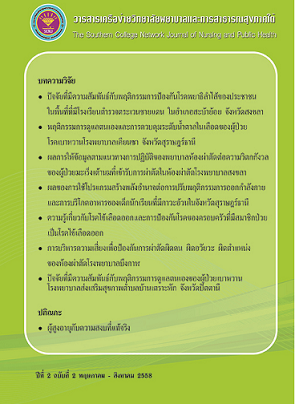ความรู้เกี่ยวกับโรคไข้เลือดออกและการป้องกันโรคของครอบครัวที่มีสมาชิกป่วยเป็นโรคไข้เลือดออก
คำสำคัญ:
ความรู้โรคไข้เลือดออก, การป้องกันโรคไข้เลือดออก, Dengue Hemorrhagic Fever, Knowledge, Disease Prevention, Family Member Affected by Dengue Hemorrhagic Feverบทคัดย่อ
การวิจัยเชิงพรรณนานี้ มีวัตถุประสงค์เพื่อศึกษาความรู้เกี่ยวกับโรคไข้เลือดออกและการป้องกันโรคของครอบครัวที่มีสมาชิกป่วยเป็นโรคไข้เลือดออกในเขตอำเภอพุนพิน จังหวัดสุราษฎร์ธานี กลุ่มตัวอย่างคือ ผู้ป่วยหรือผู้ดูแลผู้ป่วย จำนวน 175 คน โดยการเลือกแบบสะดวก เครื่องมือที่ใช้คือแบบสอบถามที่สร้างขึ้น (IOC=.86, KR-20=.82) วิเคราะห์ อมูลโดยใช้สถิติเชิงพรรณนา ได้แก่ ค่าความถี่และร้อยละ
ผลการศึกษาพบว่ากลุ่มตัวอย่างส่วนใหญ่มีความรู้เกี่ยวกับโรคไข้เลือดออกและวิธีการป้องกันโรคไข้เลือดออกอยู่ในระดับสูง (n=164, 93.71%) เมื่อพิจารณารายข้อส่วนใหญ่รู้ว่าการระบาดของโรคไข้เลือดออกเกิดจากยังควบคุมแหล่งเพาะพันธ์ยุงลายได้น้อย (n=196, 96.6%) มีความรู้เกี่ยวกับวิธีกำจัดลูกน้ำโดยการปล่อยปลา (n=171, 97.1%) เปลี่ยนน้ำในแจกันหรือถังเก็บน้ำทุก 7 วัน (n=168, 96%) แต่ที่สำคัญกลุ่มตัวอย่างยังพร่องความรู้ในเรื่องทรายอะเบทว่าสามารถใส่ในน้ำดื่มได้ (n= 145, 82.9%) เกลือน้ำส้มสายชู หรือผงซักฟอกแทนทรายอะเบทได้ (n= 72, 41.1%) ไข่ยุงลายเกาะในภาชนะที่แห้งได้นานเป็นปี (n=58, 33.1%) ควรขัดล้างภาชนะเพื่อทำลายไข่ยุงลาย (n= 37, 21.1%)
ดังนั้นบุคลากรทางสุขภาพควรตระหนักถึงการให้ความรู้แก่ประชาชนโดยเน้นความสำคัญในการประเมินความรู้และให้ข้อมูลในส่วนที่พร่องความรู้ เช่นทรายอะเบทใส่ในน้ำดื่มได้เมื่อใส่ในสัดส่วนที่เหมาะสมการขัดล้างภาชนะเพื่อทำลายไข่ยุงลาย หรือการเลือกใช้เกลือ น้ำส้มสายชู หรือผงซักฟอกที่มีอยู่ในครัวเรือนแทนทรายอะเบท เป็นต้น เพราะการกำจัดลูกน้ำยุงเป็นวิธีควบคุมโรคที่ดีที่สุด
Knowledge and Disease Prevention of Dengue Hemorrhagic Fever among Families Who Ever Had One Affected Member
The purpose of this descriptive study was to assess both knowledge and disease prevention regarding the dengue hemorrhagic fever among families in the Phunphin district of Suratthani with one of their member who ever had the dengue hemorrhagic fever. Sample was175 people who ever had the dengue hemorrhagic fever or who had ever been a caregiver in an affected family with that disease. Convenience sampling was used. The research questionnaire was developed by the researcher. Content validity and reliability of the questionnaire was confirmed (IOC=.86 and KR-20 =.82, respectively) . Data were analyzed using frequency and percentage.
The results showed that most of the patients (n=164, 93.71%) had an overall mean score of knowledge regarding the dengue hemorrhagic fever and the disease prevention at a high level. When considering each item, the samples knew that cause of the spread of dengue fever was a low control of mosquitoes’ habitat (n=196, 96.6%). They had knowledge about controlling mosquitoes by freeing fish into a water tank (n=171, 97.1%), and changing water in a vase or water tank every 7 days (n=168, 96%). The samples had knowledge at a low level in term of using abate sand in drinking water (n= 145, 82.9%); using salt or vinegar or detergent instead of abate sand (n= 72, 41.1%);the mosquito’s eggs can live in a dry container for many years (n=58, 33.1%) so containers must be washed to destroy the mosquito’s eggs (n= 37, 21.1%).
The findings of this study suggest that health care providers should realize the importance of assessing the knowledge of patients or caregivers in order to provide appropriate and useful information regarding the disease prevention, particularly using abate sand, washing water containers, and using salt or vinegar or detergent instead of abate sand. Destroying the mosquito’s eggs is the best control of the spread of dengue hemorrhagic fever.
ดาวน์โหลด
เผยแพร่แล้ว
ฉบับ
ประเภทบทความ
สัญญาอนุญาต
1. บทความหรือข้อคิดเห็นใด ๆ ที่ปรากฏในวารสารเครือข่าย วิทยาลัยพยาบาลและการสาธารณสุขภาคใต้ ที่เป็นวรรณกรรมของผู้เขียน บรรณาธิการหรือเครือข่ายวิทยาลัยพยาบาลและวิทยาลัยการสาธารณสุขภาคใต้ ไม่จำเป็นต้องเห็นด้วย
2. บทความที่ได้รับการตีพิมพ์ถือเป็นลิขสิทธิ์ของ วารสารเครือข่ายวิทยาลัยพยาบาลและการสาธารณสุขภาคใต้








